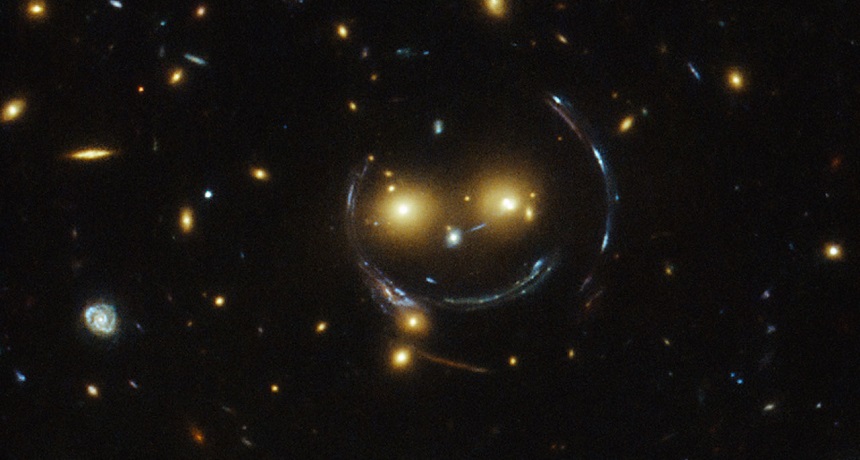Picture This: Smiley face in space!
This image was captured by cameras on the Hubble Space Telescope

The “eyes” in this face are actually galaxies — huge clusters of stars. And the smile is an optical illusion.
NASA & ESA
By Janet Raloff
In ancient times, people imagined the outlines of animals, people and more in the arrangement of the night stars above them. Many became the familiar constellations. Now astronomers have turned up what looks like a smiley face in the center of this photo. It was taken with cameras on the Hubble Space Telescope.
The face “lives” in a cluster of galaxies — each a huge community of stars. Astronomers have given this cluster a name that is hardly memorable: SDSS J1038+4849.
Two glowing orange eyes seem to hover above a nose that looks like a white button. Those eyes actually are very bright galaxies, roughly 4.5 billion light-years away. The apparent smile and edge of the face don’t truly exist. Their curving lines are a light distortion. They are due to an effect known as strong gravitational lensing, according to scientists with the National Aeronautics and Space Administration and the European Space Agency (ESA).
Galaxy clusters are huge. Indeed, they are the most massive things in the universe. Gravity due to that great heft exerts such a powerful pull that it can distort both nearby space and time. In a sense, gravity acts like the lenses in thick eyeglasses or a telescope. But a gravitational lens is so strong that it not only can magnify but also bend the light behind it. Many of Hubble’s discoveries were made possible by this lensing, NASA notes.
One hundred years ago this year, Albert Einstein first proposed this light bending by gravity as part of his theory of general relativity. Twenty-one years later, Einstein wrote a paper describing an optical illusion that this bending can create. It has since been dubbed an Einstein ring. When some massive object acts like a lens, the light it bends may appear from some great distance to curve in a partial or full circle (a ring).
In this photo, such illusions create the curved lines in the smile and face. The “eyes” provide the lensing that made the grin. Its light arrived from nearly 3 billion light-years behind those eyes.
Astronomers captured these features while using two of Hubble’s cameras to scout for strong lenses. Artist Judy Schmidt entered a version of this picture into ESA’s Hubble’s Hidden Treasures contest.
Power Words
(for more about Power Words, click here)
astronomy The area of science that deals with celestial objects, space and the physical universe as a whole. People who work in this field are called astronomers.
constellation Patterns formed by prominent stars that lie close to each other in the night sky. Modern astronomers divide the sky into 88 constellations, 12 of which (known as the zodiac) lie along the sun’s path through the sky over the course of a year. Cancri, the original Greek name for the constellation Cancer, is one of those 12 zodiac constellations.
Einstein ring Albert Einstein’s General Theory of Relativity, in 1915, proposed that gravity can bend light. This bending can create an optical illusion, now called an Einstein ring. It takes a very massive object to make one. But with enough mass, the light it bends may appear from a great distance to curve in a partial or full circle (or ring).
galaxy A massive group of stars bound together by gravity. Galaxies, which each typically include between 10 million and 100 trillion stars, also include clouds of gas, dust and the remnants of exploded stars.
galaxy cluster A group of galaxies held together by gravity. Galaxy clusters are the largest known objects in the universe.
gravitational lensing The distortion of space and time by an intense gravitational force, such as what can be exerted by clusters of galaxies — the most massive things in the universe.
gravity The force that attracts anything with mass, or bulk, toward any other thing with mass. The more mass that something has, the greater its gravity.
lens (in physics) A transparent material that can either focus or spread out parallel rays of light as they pass through it.
light-year The distance light travels in a year, about 9.48 trillion kilometers (almost 6 trillion miles).
National Aeronautics and Space Administration Created in 1958, this U.S. agency has become a leader in space research and in stimulating public interest in space exploration. It was through NASA that the United States sent people into orbit and ultimately to the moon. It has also sent research craft to study planets and other celestial objects in our solar system.
relativity A pair of theories developed by Nobel-Prize-winning physicist Albert Einstein. They hold that the laws of physics should work the same way anywhere in the universe. But nothing in the universe remains static in one place. All things are moving. The theory of relativity helps people attempt to identify the place of all of these moving things in the universe relative to themselves and other objects via these laws.
telescope Usually a light-collecting instrument that makes distant objects appear nearer through the use of lenses or a combination of curved mirrors and lenses. Some, however, collect radio emissions (energy from a different portion of the electromagnetic spectrum) through a network of antennas.







